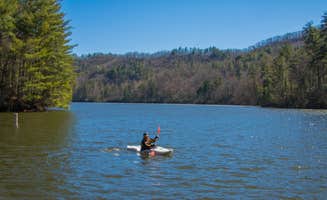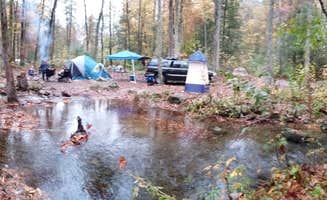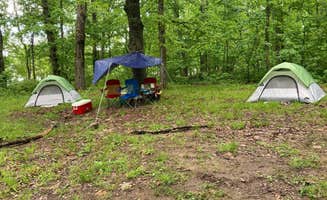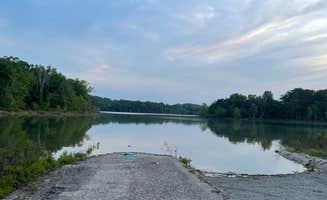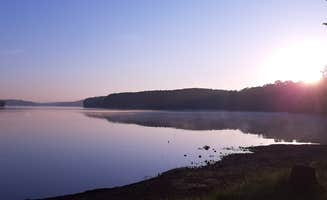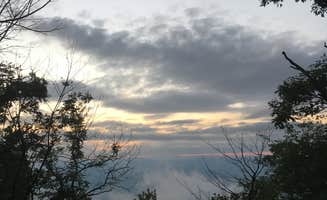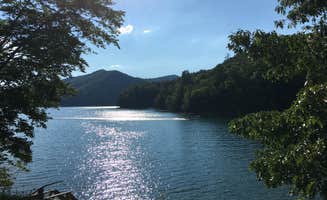Rustic camping near Louisville, Tennessee offers free dispersed sites across Cherokee National Forest with elevation ranging from 1,100 to 2,400 feet. Most undeveloped locations experience significant seasonal temperature variations with summer highs reaching 85-90°F and winter lows dropping below freezing. Sites often fill quickly during prime weekends from May through October.
What to do
Fishing opportunities: Sites along Citico Creek provide immediate access to stream fishing for rainbow and brown trout. "Cool spot right on the river. Disappointed in how some people don't take care of these spots," notes a visitor to Citico Creek Area.
Lake activities: Boat-in camping options at Calderwood Lake Primitive campground require paddling to reach secluded spots. "If you are willing to bring everything with you, pack everything out, and paddle multiple miles on a nonmotorized finger lake, this is this place for you!" reports one camper.
Hiking routes: The Slickrock Trail near Calderwood Lake offers a moderate 1.5-mile trek to Wolfcat Falls, which features a large swimming hole. A camper notes: "If you enjoy hiking campsite one is right on the slickrock trail and if you take it about 1.5 miles you'll reach wolfcat falls which has a big swimming hole at the bottom."
What campers like
Secluded sites: Lake Santeetlah Dispersed offers significant privacy between camping areas. "The sites were amazing, beautiful views, lake access, nice fire pits, good tent pads. One of the best free sites I have stayed at," says one visitor.
Level camping areas: Many locations feature pre-established flat spots for tents. A camper at Lake Santeelah Dispersed mentions: "GPS coordinates got me exactly to where I wanted to go. Some of the plots you can only fit one tent others you could fit up to three or four."
Wildlife viewing: Morning hours provide opportunities to observe native bird species. "We had lots of birds and butterflies around camp. Keep your eyes out for the Tufted Titmouse a cute little grey bird resembling a Cardinal," reports a Lake Santeetlah visitor.
What you should know
Road conditions: Forest service roads to primitive camping areas often deteriorate after rainfall. "The road to get to Lake Santeetlah has endless sharp turns & drop-offs, would not recommend driving this in the dark," warns one camper.
Site availability: Popular locations fill quickly during weekends, especially in summer. At Long Hungry Road Dispersed Campsites, a visitor observed: "Showed up around 2:30-3 o'clock on a Sunday afternoon and most of the spots were already called for. Seems you gotta get there early if you want easy water access."
Seasonal closures: Some campgrounds close entirely during winter months. One camper reports: "We've been enjoying our stay but sadly we're informed by a man driving around to be out by Nov 3 as they're closing the site for the season. Nothing is mentioned on sites or sign at entrance about this."
Tips for camping with families
Site selection: Choose locations with gradual water access for safer recreation with children. A visitor to Sourwood Campground states: "The closeness to the river is the main attraction here. Its ever-present sounds make it easy to forget everything."
Cleanliness issues: Pack supplies for cleaning campsites before setting up. "We camped at site #3 we picked up so much trash in and around our site that it was sad," reports one Citico Creek visitor.
Wildlife precautions: Proper food storage prevents unwanted animal encounters. Campers should hang food supplies at least 10 feet high and 4 feet from tree trunks when camping in Cherokee National Forest areas.
Tips from RVers
Size limitations: Sourwood Campground accommodates only smaller recreational vehicles. A camper notes: "It would absolutely NOT be a good location for a class A motorhome but maybe some of the smaller class C's could get settled in there. I saw a small camper trailer sitting comfortable. I would not like to try to get a larger camper or 5th wheel in there, way too tight to turn around."
Site leveling: Most primitive areas require significant leveling for campers and trailers. "All of the sites had solid packed ground so it would not be hard to level whatever rig you use."
Water access: No hookups exist at any of the dispersed camping locations, requiring complete self-sufficiency. RVers should bring 1-2 gallons of water per person per day, with additional supplies for cooking and cleaning.



